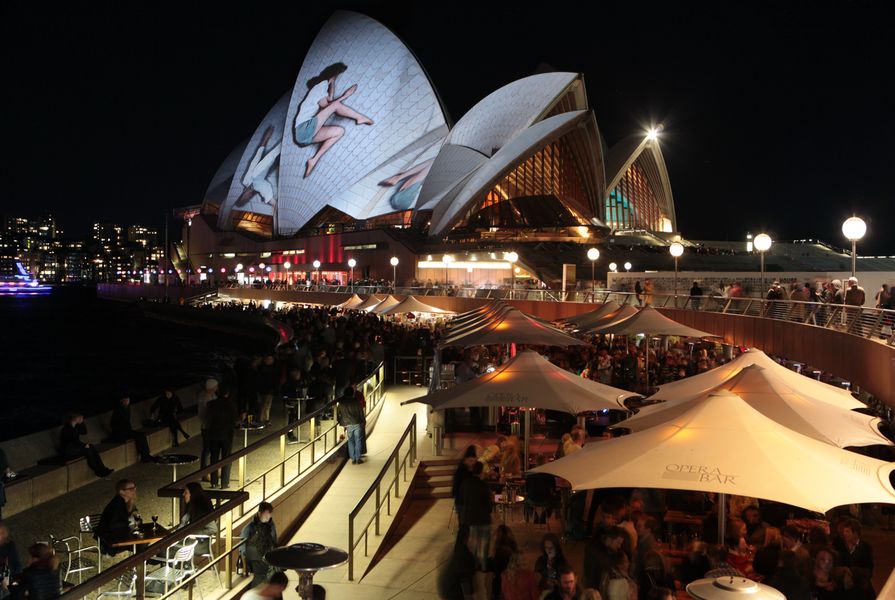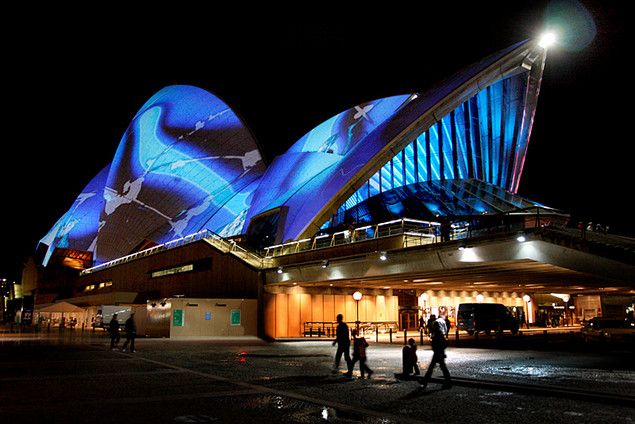For the fourth year running, the Vivid Sydney festival is lighting up the harbour city with an array of ambitious 3D video projections that put architecture in the spotlight.
According to festival director Anthony Bastic, the light installations are a true marriage of design and technology. Until 11 June, over fifty interactive and immersive projections and light art sculptures will illuminate The Rocks, Circular Quay and the Sydney Opera House. The crown jewel is UrbanScreen’s Lighting the Sails, which lights up the Sydney Opera House. It is flanked by Electric Canvas’s City Life at Customs House and will.i.am’s Play the Building, which has turned the Museum of Contemporary Art (MCA) into a musical instrument.
Brian Eno’s Luminous projections on the Sydney Opera House from 2009.
Image: JC June
The festival of light, music and ideas has had an impressive pedigree of creative talent at the helm so far. In 2009, Brian Eno played a central role in leading the music program and splayed 77 Million Paintings onto the Opera House sails. Eno’s Luminous collection was a pre-existing suite of abstract images that morphed and dissolved into one another, transforming Jørn Utzon’s icon into a kaleidoscopic chameleon.
When Laurie Anderson and Lou Reed took the festival reins in 2010, Anderson created a fresh set of textures and short video sequences for the sails. By playing with close-ups of leopard print, curls of hair, glitter, Japanese fabric and water droplets she dressed up the white canvas of a million tiles.
In 2011, French artist group Superbien was invited to light the sails and its response used 3D mapping and psychedelic colour spectrum to heighten the form of the building.
This year, German collective UrbanScreen is taking a rigorously precise architectonic approach that explores both the sculptural form of the Sydney Opera House and its role as Australia’s pre-eminent home for the performing arts.
“The basic idea was to outline the characteristics of the sculpture-like building. The employment of graphics and human performers enabled us to describe the rounded shapes and features of the facade vividly,” explain art directors Till Botterweck and Max Goergen.
Laurie Anderson’s textural vision for Lighting the Sails from Vivid Sydney 2010.
Image: CoolHunting
Collaborating with seasoned Vivid Sydney outfit Electric Canvas – Australian experts in large-scale site-specific video projections – reinforced the fact that the Sydney Opera House is seen from all angles rather than a single postcard view. With no 3D CAD models or accurate 2D plans available, UrbanScreen was presented with three vital pieces of information on which to base its artistic vision. The first was a set of 2D templates mapping all the tiles; the second was the high-resolution laser Total-Station surveying imagery providing accurate coordinates of points on the sails and projectors; and finally, managing director of Electric Canvas Peter Milne presented UrbanScreen with the same “segmented orange” spherical solution that Utzon proposed to his engineers as the solution to building the shells.
While not nearly as colourful a vision as previous incarnations, UrbanScreen’s 3D video projection reveals more of the intricacies of Utzon’s architecture in its subtlety and understatement. In the thirty-minute loop, oversize dancers appear curled up in and tucked against the ribs of the shell forms. Their twists, turns and minuscule movements ripple through the tiles, drawing attention to the tessellations that pattern the surface. As the sequence progresses, the hyper-real structure transmutes into a billowing canvas and eventually crumples away as if it is merely a paper model being crushed by an unseen force. The visual transformation is amplified to eerie effect with an ambient soundtrack that can be heard from the forecourt and across at the Oversees Passenger Terminal by virtue of PA address systems tuned to a public FM frequency.
“We like to enhance the video animation with sound and live performance to make it more realistic and emotional,” says Botterweck.
City Life by Electric Canvas at Customs House.
Image: David Clare courtesy of VividSydney
“Ultimately, we’d like the impression that lingers in people’s minds to be one of joy,” agrees Goergen.
Festival visitors can “play the building” through an interactive installation that triggers music loops by Black Eyed Peas frontman will.i.am.
Image: David Clare courtesy of Vivid Sydney
For Customs House, Electric Canvas’s art department spent over two thousand hours designing, compiling and compositing the eight-minute video animation City Life. Conceived as an elaborate “city within a city,” this highly detailed and playful sequence uses 3D mapping technologies to accurately render every aspect of the ornate building in plan and elevation. As well as delineating every column, arch and cornice, the differing depths of the facade are also registered so the animated character can make his way through a labyrinth of buildings, streets, traffic and the everyday bustle of urban living. The projections routinely garner generous applause at the end of every loop, giving an indication of the level of delight that audiences experience when light, art and architecture collide to change our view of the cityscape.
Over the water at the MCA, Spinifex has crafted a vibrant projection inspired by Russian Constructivism for the old wing and collaborated with Black Eyed Peas frontman will.i.am to activate the new wing as an interactive musical instrument. Festival goers’ gestures and movements are tracked and trigger will.i.am’s music loops to sync visuals on a purpose-built interface so they can literally “play the building.” To will.i.am, the project highlights the magic that can be created when innovative minds and technology come together.
This year at Vivid Sydney, everyone gets to play in a pool of light, music and ideas. Jump in!
The Vivid Sydney lights, as well as the festival shows and talks, conclude at midnight on Monday 11 June.
Read more about the light artwork sub|version here.
Customs House Time Lapse from Vivid Sydney on Vimeo.



































